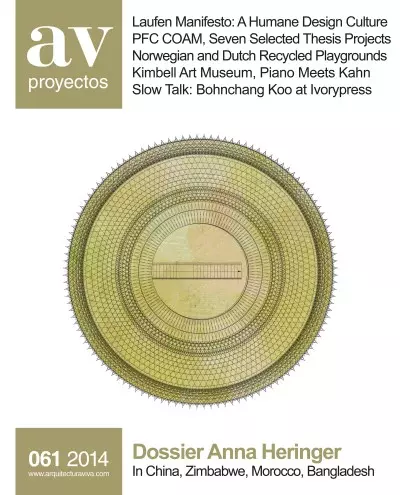

(Alemania, 1977)
Light, smells, colors, temperature, textures, sounds… It must be overwhelming to leave a mother’s womb and get born into this world. What should the very first space we ever experience be like? What kind of material should it be made of to make newbo
In Rudrapur, a village in the Dinajpur District of northern Bangladesh, stands this mud and bamboo construction that houses a therapy center for people with disabilities and a workshop for Dipdii Textiles, a clothes-making project for local women tha
Consisting of two hostels and a guest house, the complex built for the Longquan Bamboo Biennale typologically and constructively reinterprets local traditions. The floor plan is devised as a series of concentric rings of differing condition and mater
This house for three peasant families follows the pattern of traditional homestead in Bangladesh, keeping the kitchen and the sanitary units in external buildings, and leaving remaining land for gardening as a means to overcome the food crisis. Sensi
Drawing inspiration from the ksar and the madrasa – Maghrebi fortified cities and schools –, and combining local knowledge with modern technology, the project reinvents earth as building material able to fulfill current comfort needs and safety requi
This project that has the ability to turn to compost, leaving no remains, is formed by a multifunctional room, a surrounding bench and a timber structure that has enough depth to form niches, an alcove and colorful windows with solid frames...
The project wishes to reflect the cultural identity of the place; hence, the traditional ceramic of the region inspires the rounded forms of the building, imitating the typical vessels and building materials used. The walls are built with rammed eart
Construida con técnicas tradicionales y materiales locales como el barro y el bambú, esta escuela de formación profesional reinterpreta la arquitectura vernácula bangladesí.
Con técnicas constructivas tradicionales de la región —tierra apisonada y bambú— y la participación como mano de obra de los vecinos de la aldea se ha levantado una escuela rural.
For centuries, and as a logical response to material availability, the global construction standard has been earth. The rise of industrialization caused this system to lose ground to concrete and steel, but with the current climate crisis earth has r
The pandemic and all the other crises coinciding with it have been putting a halt to the pillars of our economic, social, and political frameworks. They have also led to an overall revision of architecture. Some say that it’s a matter of resilience,
Heringer at ICO
The Museo ICO’s exhibition on Anna Heringer is a celebration of her deep commitment, in both ideas and actual work, to the planet and to society.
The Museo ICO presents a monographic exhibition on the work of the German architect Anna Heringer and her deep interest in the sustainable development of our society and built environment. Through the use of local materials and techniques, she seeks
On view through 8 May 2022 at the Museo ICO in Madrid is a retrospective show on Anna Heringer (Rosenbeim, Germany, 1977), the first to be seen in Spain. Curated by Luis Fernández-Galiano, it leads the visitor through the work and philosophy of this
This coming Wednesday, 9 February, Museo ICO inaugurates ‘Anna Heringer: Essential Beauty’, curated by Luis Fernández-Galiano and organized by Fundación ICO. For the first time in Spain, an exhibition focuses monographically on Anna Heringer (Rosenh
The Obel Award is an international prize that honors recent, outstanding architectural contributions to human development, with the winner receiving €100,000 and an artwork. The second winner of the OBEL AWARD is the Anandaloy project in Bangladesh,
In the village of Rudrapur, located in the Dinajpur Disrtict of northern Bangladesh, the German architect Anna Heringer – in conjunction with Veronika Lang and the non-profit organization Dipshikha – recently completed a therapy center for people wit
Xitou Village, hidden in the green hills and clear waters of Baoxi Town, Longquan City (Zhejiang Province), is one of the birthplaces of the Celadon ceramic culture. Inconvenient transportation somewhat shields it from the influence of rapid urbaniza
‘Not the old, not the new, but the necessary.’ Tatlin’s quote gave the cue for the third congress of the Fundación Arquitectura y Sociedad, held in Pamplona in June 2014. Like the two previous conferences, celebrated in 2010 and 2012, the event gathe
The works and projects of these three builders of the necessary stand for a return to reality and to the material, social, and cultural roots of architecture.
At the ICO Museum in Madrid, ‘The Architect is Present’ documents the exemplary work carried out by five practices in contexts of extreme scarcity.
On view from 14 March to 18 May at the ICO Museum in Madrid is ‘The Architect is Present’, an exhibition that, in a paraphrasing of Marina Abramovic’s ‘The Artist is Present’ performance, takes stock of the work of five influential international prac
Launched by the Germans Anna Heringer and Andres Lepik, the Laufen Manifesto promotes a general paradigm shift regarding the role of architecture in our society, asserting the power of design as a tool that can significantly improve the living condit
En los países en desarrollo, la defensa de lo común no es una postura intelectual, sino un modo de vida. Tal es el mensaje de la obra de Heringer, construida con materiales tradicionales.
El centro de formación de Chwiter, situado en las afueras de Marrakech y diseñado por Anna Heringer, Martin Rauch, Elmar Nägele, Ernst Waibel y Salima Naji, tiene como objetivo ofrecer a los jóvenes formación profesional. En este contexto, la constr

